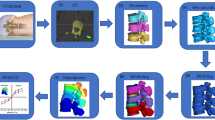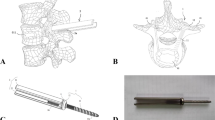Abstract
Infiltrating osteoporotic cancellous bone with bone cement (vertebroplasty) is a novel surgical procedure to stabilize and prevent osteoporotic vertebral fractures. Short-term clinical and biomechanical results are encouraging; however, so far no reports on long-term results have been published. Our clinical observations suggest that vertebroplasty may induce subsequent fractures in the vertebrae adjacent to the ones augmented. At this point, there is only a limited understanding of what causes these fractures. We have previously hypothesized that adjacent fractures may result from a shift in stiffness and load following rigid augmentation. The purpose of this study is to determine the load shift in a lumbar motion segment following vertebroplasty. A finite-element (FE) model of a lumbar motion segment (L4-L5) was used to quantify and compare the pre- and post-augmentation stiffness and loading (load shift) of the intervertebral (IV) disc adjacent to the augmented vertebra in response to quasi-static compression. The results showed that the rigid cement augmentation underneath the endplates acted as an upright pillar that severely reduced the inward bulge of the endplates of the augmented vertebra. The bulge of the augmented endplate was reduced to 7% of its value before the augmentation, resulting in a stiffening of the IV joint by approximately 17%, and of the whole motion segment by approximately 11%. The IV pressure accordingly increased by approximately 19%, and the inward bulge of the endplate adjacent to the one augmented (L4 inferior) increased considerably, by approximately 17%. This increase of up to 17% in the inward bulge of the endplate adjacent to the one augmented may be the cause of the adjacent fractures.


Similar content being viewed by others
Reference
Adams MA, Hutton WC (1983) The effect of posture on the fluid content of lumbar intervertebral discs. Spine 8: 665–671
Baroud G, Willmann G, Kreissig R (1997) The effect of the stem coating of the postoperative stress state of the femur. Biomed Tech 43:25–28
Baroud G, Görke U, Beckman L, Steffen T (2001) Physical changes of the vertebral tissue treated with vertebroplasty. Proceedings of the Eighteenth Congress of the International Society of Biomechanics (ISB), p. 728, 8–13 July, Zürich
Baroud G, Nemes J, Ferguson SJ, Steffen T (2003) Material changes in osteoporotic human cancellous bone following infiltration with acrylic bone cement for a vertebral cement augmentation. Comp Methods Biomech Biomed Eng 6:133-139
Belkoff SM, Mathis JM, Erbe EM, Fenton DC (2000) Biomechanical evaluation of a new bone cement for use in vertebroplasty. Spine 25:1061–1064
Berlemann U, Ferguson SJ, Nolte LP, Heini PF (2002) Adjacent vertebral failure after vertebroplasty. A biomechanical investigation. J Bone Joint Surg Br 84:748–752
Brinckmann P, Frobin W, Hierholzer E, Horst M (1983) Deformation of the vertebral end-plate under axial loading of the spine. Spine 8:851–856
Cotten A, Boutry N, Cortet B et al (1998) Percutaneous vertebroplasty: state of the art. Radiographics 18: 311–320
Eberlein R, Holzapfel GA, Suhulze-Bauer CAJ (1998) An anisotropic constitutive model for the annulus tissue and enhanced finite element analysis of intact lumbar disc bodies. Comput Methods Biomech Biomed Eng 4:209–230
Ferguson S, Berlemann U, Heini PF, Nolte LP (2001) Evaluation of adjacent segment failure following vertebroplasty. Proceedings of the 47th Annual Meeting, of the Orthopaedic Research Society (ORS), p. 280, San Francisco
Galibert P, Deramond H, Rosat P, et al (1987) Preliminary note on the treatment of vertebral angioma by percutaneous acrylic vertebroplasty. Neurochirurgie 33:166–168
Heini PF, Walchli B, Berlemann U (2000) Percutaneous transpedicular vertebroplasty with PMMA: operative technique and early results. A prospective study for the treatment of osteoporotic compression fractures. Eur Spine J 9:445–450
Heini PF, Berlemann U, Kaufmann M, et al (2001) Augmentation of mechanical properties in osteoporotic vertebral bones—a biomechanical investigation of vertebroplasty efficacy with different bone cements. Eur Spine J 10:164–171
Jensen ME, Evans AJ, Mathis JM, et al (1997) Percutaneous polymethylmethacrylate vertebroplasty in the treatment of osteoporotic vertebral body compression fractures: technical aspects. AJNR 18:1897–1904
Nachemson AL (1963) The influence of spinal movement on the lumbar intradiscal pressure and on tensile stresses in annulus fibrosus. Acta Orthop Scand 33:183–207
Riggs BL, Melton LJ (1995) The worldwide problem of osteoporosis: insights afforded by epidemiology. Bone 17[5 Suppl]: 505–511
Rockoff SD, Sweet E, Bleustein J (1969) The relative contribution of trabecular and cortical bone to the strength of human lumbar vertebrae. Calcif Tissue Res 3:163–175
Schildhauer TA, Bennett AP, Wright TM, et al (1999) Intravertebral body reconstruction with an injectable in situ-setting carbonated apatite: biomechanical evaluation of a minimally invasive technique. J Orthop Res 17:67–72
Shirazi-Adl A, Drouin G (1987) Load-bearing role of facets in a lumbar segment under sagittal plane loadings. J Biomech 20:601–613
Smit TH, Odgaard A, Schneider E (1997) Structure and function of vertebral trabecular bone. Spine 22:2823–2833
Wilson DR, Myers ER, Mathis JM, et al (2000) Effect of augmentation on the mechanics of vertebral wedge fractures, Spine 25:158–165
Acknowledgement
This work was supported by the Canadian Institute of Health Research (CIHR) grant no. MOP 57835.
Author information
Authors and Affiliations
Corresponding author
Rights and permissions
About this article
Cite this article
Baroud, G., Nemes, J., Heini, P. et al. Load shift of the intervertebral disc after a vertebroplasty: a finite-element study. Eur Spine J 12, 421–426 (2003). https://doi.org/10.1007/s00586-002-0512-9
Received:
Revised:
Accepted:
Published:
Issue Date:
DOI: https://doi.org/10.1007/s00586-002-0512-9




